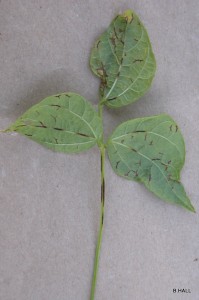
The first suspect cases this season of anthracnose have been reported in white beans. This is the time of year when we typically first begin to see symptoms and is a good reminder for the need to scout your fields through to leaf drop. Anthracnose is a potentially devastating seed-borne disease that can affect all classes of beans, impacting both yield and quality. Anthracnose is also very costly to the Ontario dry bean industry affecting our reputation as source of quality commercial product and costly and time consuming process for dealers to remove discoloured beans. In 2010 a major outbreak of the disease occurred in white beans and dealers implemented a special discount schedule for anthracnose infected samples because of the high incidence of the disease.
Ontario Grown Seed has higher risk: While the disease can affect all classes of edible beans, western produced seed has been problem free. Ontario produced seed has added risk because of our suitable environment for the disease. Most Ontario produced seed receives a fungicide for anthracnose, and field inspections. There were no reports of anthracnose infected fields in 2013.

Scouting Leaf symptoms first appear on the underside of the leaf surface along the veins, which show a brick red to purplish-red discolouration. Later such discolouration also appears on the upper leaf surface. On stems, dark brown eye-spots develop lengthwise along the stem. Pods develop rusty-brown spots that later become brown sunken cankers which may contain pink to flesh coloured masses of spores. the borders of cankers are well defined by a dark brown rim. Seed from infected pods will show brown to light chocolate coloured spots on the seed coat.

Focus scouting to low lying areas, water runs and along fence rows and headlands of fields where the disease often first appears, because anthracnose is spread by movement of water in a field.
Disease Spread
Rain storms with gusting winds can blow spore-laden rain drops more than 12 feed away from infected plants. Local infested hot spots spread with storms, or movement of spores by machinery, people or animals through a field. Spores are easily spread in a field, especially when the canopy is wet. Humidity alone is not enough to spread the disease, and the canopy must be wet from heavy dew or rain. Conditions which are favourable for white mould are also good for anthracnose. New infections and additional spore production occur in 7-14 days depending on weather and crop conditions
Recommended Treatment
Optimum disease control will be obtained when a protectant fungicide, Headline (BASF) or Quadris (Syngenta) is applied prior to establishment of anthracnose. Optimum timing of first application is at 20-50% bloom stage to minimize yield losses and seed infection. If infection is detected prior to bloom, fungicide application is warranted in reducing the disease spread, but a second application may be required to protect pod and seed development. Applications at late flower or pod fill are not always effective in reducing yield losses or preventing a high level of seed infection depending on the amount of infection that is present at time of application. Both Headline and Quadris are very effective and can help limit the spread of the disease that may already be present in a field if detected early. The initial early application of fungicide at flowering is designed to protect yield and quality, while a later application during pod fill can limit seed infection and discolouration. Long term research trials conducted by Chris Gillard, RCAT, University of Guelph indicate that Headline is slightly more effective than Quadris when disease pressure is high. A later or second application of fungicide may be required 10-14 days later the initial application timing if wet weather continues and or a dense crop canopy exits. The pre-harvest interval for Quadris is 15 days and 30 days for Headline.
Application Notes
Consult the product label for timing and application instructions. Both fungicides act as a protectant and thus thorough coverage of foliage is critical. Water volumes directly affect spray coverage, 20-30 US gal/ac is recommended
Best Management Practices
Anthracnose can be spread through field easily, but much more easily when the canopy is wet. Where practical use equipment in infected fields last. Disinfect equipment between fields with a bleach solution using a high-pressure washer. Harvest heavily infected fields last, isolate heavily infected areas and notify your bean dealer prior to delivery. Since this is seed borne disease, be particularly careful in managing seed fields. Race 73 is the most prevalent race of anthracnose in Ontario dry beans. Several varieties of white bean have resistance to Race 73. Refer to Ontario Dry Bean Performance trial info-sheet on the gobeans.ca website for variety information. Website: http://www.gobeans.ca/
Plant sample diagnosis
To confirm that the disease is present, collect several suspect plants, remover dirt from the roots and deliver samples in plastic bag too: University of Guelph Laboratory Services 95 Stone Road, Guelph, On, N1H8J7 Phone: 519-767-6256
